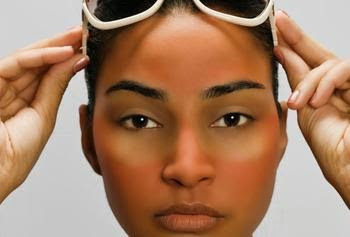SKINCARE TALK WITH BOLA-AKINBOADE BELLO:I HAVE SUNBURN, WHAT SHOULD I DO NOW?
In today’s
world many Australians are familiar with the pain and discomfort of sunburn.
Most of us have been sunburnt at least once in our lives, and many people get
sunburnt regularly every summer.
world many Australians are familiar with the pain and discomfort of sunburn.
Most of us have been sunburnt at least once in our lives, and many people get
sunburnt regularly every summer.
Ultraviolet
(UV) radiation from the sun or artificial sources such as a solarium (tanning
bed) can cause sunburn. Sunburn occurs when the amount of UV radiation your
skin is exposed to is more than its ability to protect itself with melanin –
the pigment that gives our skin its colour and acts to absorb UV radiation
before it can damage skin cells.
(UV) radiation from the sun or artificial sources such as a solarium (tanning
bed) can cause sunburn. Sunburn occurs when the amount of UV radiation your
skin is exposed to is more than its ability to protect itself with melanin –
the pigment that gives our skin its colour and acts to absorb UV radiation
before it can damage skin cells.
Skin that
has been sunburnt turns red within hours – and the sunburn will continue to
develop for the next one to three days. Most people who have been sunburnt also
peel – which is the body’s way of shedding dead and damaged skin cells and
making way for the new skin underneath.
has been sunburnt turns red within hours – and the sunburn will continue to
develop for the next one to three days. Most people who have been sunburnt also
peel – which is the body’s way of shedding dead and damaged skin cells and
making way for the new skin underneath.
You can’t
see or feel UV radiation. It is present every day, can be high even if the
temperature feels cool and can pass through light cloud cover.
see or feel UV radiation. It is present every day, can be high even if the
temperature feels cool and can pass through light cloud cover.
The amount
of time it takes to be sunburnt will depend on your skin type (fair skin will
burn faster than dark skin), time of day and time of year (UV levels at the
time the exposure occurs) and your environment (cement, sand, water and snow
are highly reflective). For example, if you are by the pool you are exposed to
direct sunlight from the sky as well as the reflected sunlight from the water.
of time it takes to be sunburnt will depend on your skin type (fair skin will
burn faster than dark skin), time of day and time of year (UV levels at the
time the exposure occurs) and your environment (cement, sand, water and snow
are highly reflective). For example, if you are by the pool you are exposed to
direct sunlight from the sky as well as the reflected sunlight from the water.
Unfortunately
even though sunburn eventually fades, long term damage to skin cells remains.
Even mild sunburn can increase your risk of developing melanoma and the more
often you are burnt and the more severe the sunburn is, the higher your risk
will be.
even though sunburn eventually fades, long term damage to skin cells remains.
Even mild sunburn can increase your risk of developing melanoma and the more
often you are burnt and the more severe the sunburn is, the higher your risk
will be.
How many of
you have ever experienced sunburn? I’m guessing that almost all of us have,
could have been indirectly, meaning you didn’t even know, with an embarrassing
blush! Yes, we know it’s wrong and we kick ourselves when we are wincing with
pain as we try to dress. But maybe if we truly understood what is happening to
our skins as we nonchalantly lay in the sun for that extra 10 minutes, we
wouldn’t be so lax.
you have ever experienced sunburn? I’m guessing that almost all of us have,
could have been indirectly, meaning you didn’t even know, with an embarrassing
blush! Yes, we know it’s wrong and we kick ourselves when we are wincing with
pain as we try to dress. But maybe if we truly understood what is happening to
our skins as we nonchalantly lay in the sun for that extra 10 minutes, we
wouldn’t be so lax.
Sunburn is
the skin’s response to extreme ultraviolet (UV) exposure and indicates severe
damage. In as little as 10 minutes of intense UV exposure, the skin sets into
motion a system of defense against this enemy. The first indication of damage
is redness. This is the body’s inflammatory response in situations requiring
repair and is a result of dilating blood vessels. The skin will then start to
lose moisture and hydration, which will be apparent with a feeling of
tightness. Slowly, skin cells will start to thicken and melanin pigment will be
produced (tanning) in an attempt to stop the UV rays from penetrating through
to the deeper layers and damaging the DNA of the cells. When the skin is
exposed to high levels of sunlight this may result in hypo or hyperpigmentation
which appears as irregular light or dark patches. The body is excellent at
coping with minimal amounts of damage, but if exposure is greater than the
body’s ability to repair and mop up, more serious consequences may result. If
DNA is damaged and its repair mechanisms are inhibited, skin cancer may occur.
the skin’s response to extreme ultraviolet (UV) exposure and indicates severe
damage. In as little as 10 minutes of intense UV exposure, the skin sets into
motion a system of defense against this enemy. The first indication of damage
is redness. This is the body’s inflammatory response in situations requiring
repair and is a result of dilating blood vessels. The skin will then start to
lose moisture and hydration, which will be apparent with a feeling of
tightness. Slowly, skin cells will start to thicken and melanin pigment will be
produced (tanning) in an attempt to stop the UV rays from penetrating through
to the deeper layers and damaging the DNA of the cells. When the skin is
exposed to high levels of sunlight this may result in hypo or hyperpigmentation
which appears as irregular light or dark patches. The body is excellent at
coping with minimal amounts of damage, but if exposure is greater than the
body’s ability to repair and mop up, more serious consequences may result. If
DNA is damaged and its repair mechanisms are inhibited, skin cancer may occur.
WHY DOES THE
SKIN PEEL?
SKIN PEEL?
Peeling
after sunburn is your body’s way of getting rid of the damaged cells that are
at risk of “losing control” and becoming cancerous. Due to this danger, all
damaged cells are instructed to commit suicide by repair mechanisms within
these cells. This mass suicide of cells results in whole layers of damaged skin
peeling off, to be replaced by other cells underneath those layers.
after sunburn is your body’s way of getting rid of the damaged cells that are
at risk of “losing control” and becoming cancerous. Due to this danger, all
damaged cells are instructed to commit suicide by repair mechanisms within
these cells. This mass suicide of cells results in whole layers of damaged skin
peeling off, to be replaced by other cells underneath those layers.
I HAVE
SUNBURN, WHAT SHOULD I DO NOW?
SUNBURN, WHAT SHOULD I DO NOW?
First of
all, you should take care of the cause of your problem: get out of the sun
immediately. Drink plenty of water as you may be dehydrated. If skin is
severely blistered, seek help from a medical practitioner. Otherwise it is
important to take down the inflammation and try to reduce damage to the deeper
layers of your skin.
all, you should take care of the cause of your problem: get out of the sun
immediately. Drink plenty of water as you may be dehydrated. If skin is
severely blistered, seek help from a medical practitioner. Otherwise it is
important to take down the inflammation and try to reduce damage to the deeper
layers of your skin.
Take a cool
bath (no products added) and then blot skin dry. Avoid greasy creams, which
prevent the skin from cooling and may make the situation worse. Rather, apply
generously a soothing after-sun gel to red areas and then stay out of the sun
and the heat. Look for ingredients such as Clove, Licorice, Lavender, Cucumber
and Yucca to reduce irritation, pain and redness. Also look out for an
incredible ingredient called Japanese Alder to accelerate the repair of UV
induced DNA damage. Couple this with ingredients such as Algae and Hyaluronic
Acid to rehydrate the skin and you should be well on your way to a calmer skin.
bath (no products added) and then blot skin dry. Avoid greasy creams, which
prevent the skin from cooling and may make the situation worse. Rather, apply
generously a soothing after-sun gel to red areas and then stay out of the sun
and the heat. Look for ingredients such as Clove, Licorice, Lavender, Cucumber
and Yucca to reduce irritation, pain and redness. Also look out for an
incredible ingredient called Japanese Alder to accelerate the repair of UV
induced DNA damage. Couple this with ingredients such as Algae and Hyaluronic
Acid to rehydrate the skin and you should be well on your way to a calmer skin.
But hay! It
is not then ok to go out into the sun the next day for another blast! Remember,
your skin is still trying to heal and so must be kept out of direct sunlight
for a good few days. Keep in mind, the skin is a great record keeper and even
with a great after-sun product, irreparable damage may have occurred in the
form of premature aging or skin cancer that may only reveal itself later. Think
twice next time you decide “just another ten minutes;” your immune system is
listening!
is not then ok to go out into the sun the next day for another blast! Remember,
your skin is still trying to heal and so must be kept out of direct sunlight
for a good few days. Keep in mind, the skin is a great record keeper and even
with a great after-sun product, irreparable damage may have occurred in the
form of premature aging or skin cancer that may only reveal itself later. Think
twice next time you decide “just another ten minutes;” your immune system is
listening!
(Bola
Akinboade-Bello is a lifestyle blogger, fashion designer and beauty
therapist/cosmetologist. She started her journey into the fashion and beauty
industry as a model in 1999 and modelled for top fashion and beauty brands. In
March 2006, she joined City People Media Group as a style writer, and rose with
a short period to become the Fashion Editor. Her clothing line, Betyl BAT
Clothing and Accessories and natural skincare range, Chanterelle Skincare, are
doing great in the market)
Akinboade-Bello is a lifestyle blogger, fashion designer and beauty
therapist/cosmetologist. She started her journey into the fashion and beauty
industry as a model in 1999 and modelled for top fashion and beauty brands. In
March 2006, she joined City People Media Group as a style writer, and rose with
a short period to become the Fashion Editor. Her clothing line, Betyl BAT
Clothing and Accessories and natural skincare range, Chanterelle Skincare, are
doing great in the market)
Latest posts by bebeakinboade (see all)
- HOW TO DRESS LIKE PARISIAN WOMEN: ACHIEVING EFFORTLESS CHIC - August 14, 2024
- THE BRAVE ADVENTURE OF JOSH THE GREAT: A FAITH-FILLED JOURNEY OF COURAGE AND FORGIVENESS - August 14, 2024
- FASHION AND BEAUTY ICONS FROM AROUND THE WORLD - July 28, 2024




